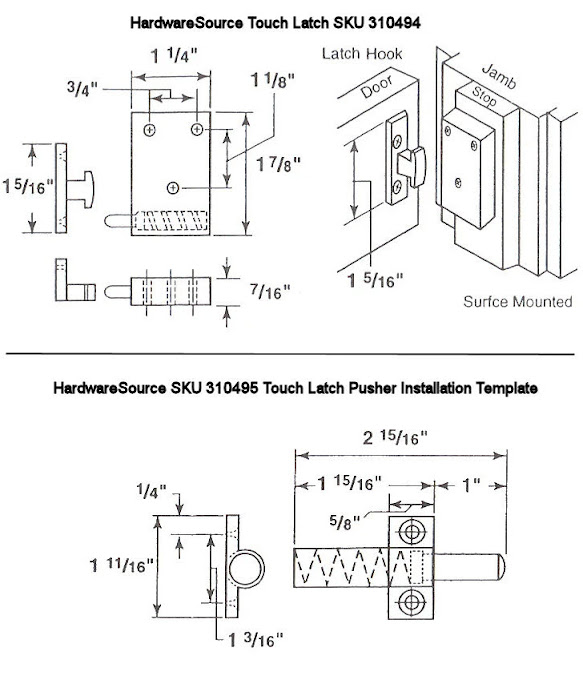This ladder for 25" x 64" rough opening gave access for perhaps thirty years, to vast storage space over a hardware store. It is a Louisville industrial attic ladder, typical of USA construction, with flimsy 1/4" plywood door and operating hardware of far less durability than the worthy step sections; now to be scrapped. The rivets of 1x4 structure over the door panel are broken away. When standing at the opening end of the door, there is little rotational rigidity of the aluminum steps. There is an awful feeling that the ladder is not safe.
A bit unusual for a hardware store, the ceiling is up more than eleven feet (135").
A long metal pole, hook-tipped, has allowed operation from the floor. The slam-close door has no latch. Just pull it down. Use the same pole to hook and walk-out the step sections to the floor. The step section pull is also a high reach, nearer hinges, the better to resist toppling.
How could these flimsy arms without elbow locks, do much to restrain door rotation when the very tentative door rigidity is lost?
See the typical USA-ladder unstable offset of the spring pull from the upper pivot. The next failure mode, usually the killer of these unfortunate ladders, is in bending-back of the spring pull offset, perhaps when snagged by some object or personal clothing. Once bent there is no stability of the arm shape. Bending often begins with failure of the rivet attachment of the arms upper pivot due to large rotation of the ladder frame where installers don't know to drive long screws through two of the four holes in the square pivot plate, obviously for that purpose.
See failure here to install the upper pivot bonding to rough framing, so very common. The 1x4 ladder frame is not rigid.
In passing, look for an alternative available to anyone. This might be among offerings of Rainbow Attic Stair, imported by SP Partners LLC, focusing on F-series, a very pretty industrial ladder rated to carry 570 pounds, with a 1/2" thickness plywood door, not fire-rated. These ladders are offered only with three step sections.
A really-pretty steel ladder powder-coated white, with very many clever features for user-friendliness and safety.
Here is a video description:
Offered Model F22/60-11 at in excess of $2000, will not reach 11' 3". There is no adjustment flexibility in the rigid welded-steel assembly.
A Rainbow ladder that will serve at 11' 3" is Model Prestige:
Also not fire-rated. I find this uninteresting. I installed three of these between 2006 and 2007, and find them wobbly and not "industrial."
- 350 lb. weight capacity
- 7′-4″ to 11′-6″ (Varies by model – see specifications for details)
- Self adjusting stair rise
- All powder coated steel stair components.
- Strong 3/4″ melamine finish MDF frame
- Built-in 2″ steel trim – No ceiling molding needed
- 2″ Styrofoam insulated door – melamine finished on both sides
- Weather stripping to reduce drafts and air leaks
- Specialized steel hangers to simplify installation
- All steel, telescoping handrail (reversible)
- All steel grab handles at top of stair
- Protective floor bumpers
- Pole and hook for operating stair
A Swedish MidMade LEX that is fire-rated, will exceed "professional" status of any other usable ladder, at large cost savings.
My ready replacement for the Louisville ladder is a made-in-Sweden MidMade LEX 70 with 56 cm x 136 cm frame, which may be customized to serve very well, but only by me. MidMade ladders are imported to USA exclusively by Conservation Technology, in Baltimore MD. Attic ladders and access doors are a secondary opportunity to sales of superior European building gaskets and much more. The only ladder imported is the LEX 70, in frame sizes 56 cm x 118 cm and 56 cm x 136 cm. The measured maximum reach of the default larger MidMade ladder is 118.5".
And here is the installed ladder, with many inventions:
Ladder deployment is with the same hook-tipped large pole used for the Louisville ladder.
Where this commercial opportunity is to a ceiling with two layers of good drywall, 5/8" first, 1/2" below, there is seeming intent of much resistance to propagation of fire. The drywall is completion of 2x12@24 box beam super-flooring, where top webbing is 1x8 excellent shiplap. But, fire safety concern is real. Where ever did we get a notion that any attic ladder may be not-fire-rated? So, I did what what was possible. Someday at my prompt, MidMade might build all attic ladders as fire-rated, and I have promised swap-out of the frame and door then at very little cost.
Here are views of the completed installation:
Stowed:
Here is a YouTube video of the deployment and stowage of this MidMade ladder:
Call the story: Someone forgot to turn off the attic lights.









































